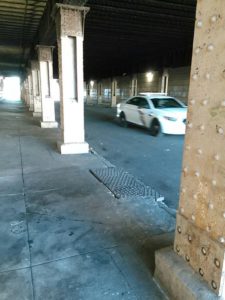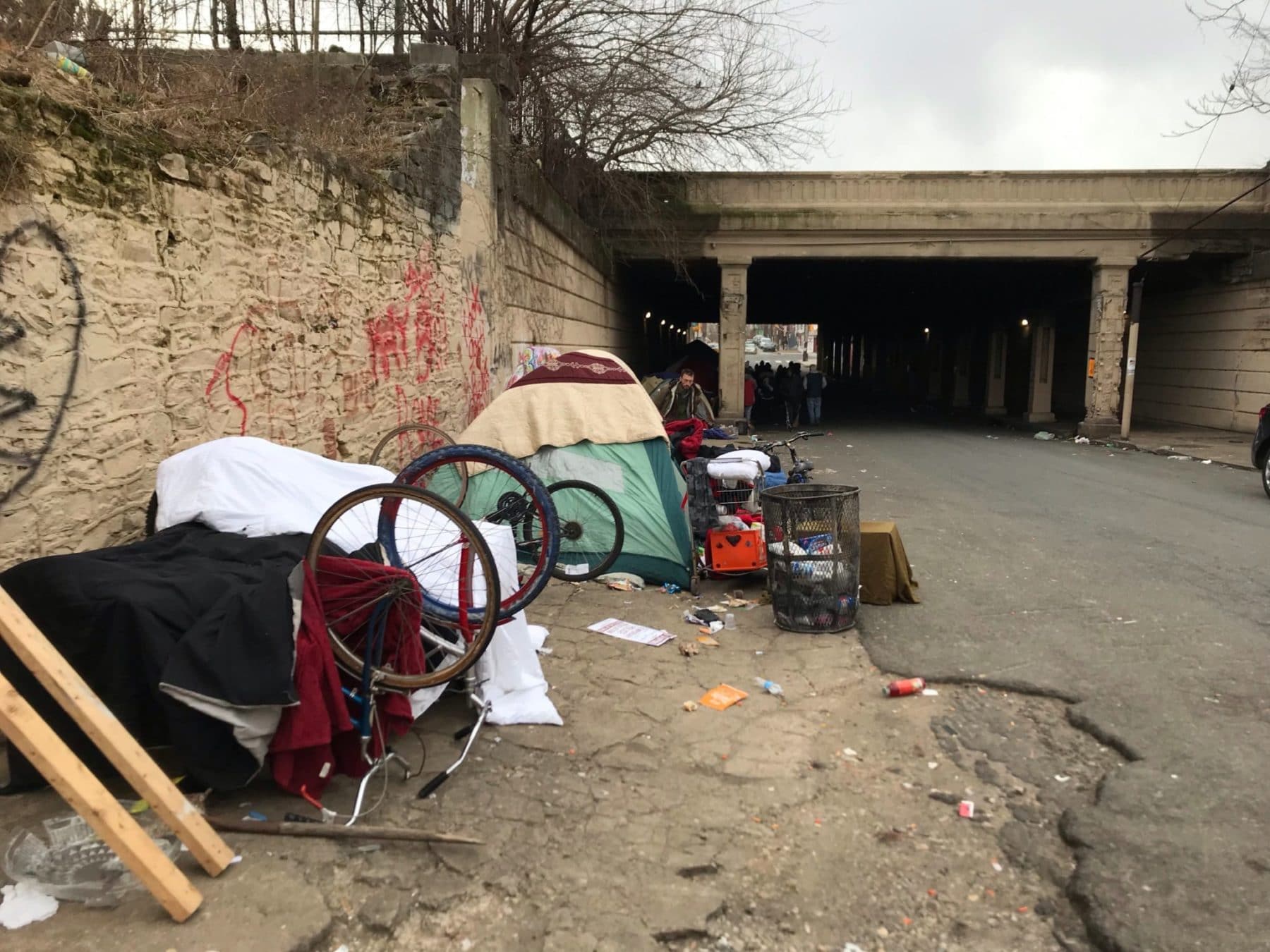Just after 5 am on January 31, a small army of police, city officials and outreach workers descended on the East Kensington neighborhood of Philadelphia. Its goal was to remove “Emerald City” (pictured above), the last of four drug-user camps that popped up in the wake of the 2017 closure of “El Campamento”—a sizable, largely hidden drug-user site in West Kensington that became a subject of sensationalized media reports.
Police arrived blaring their horns to wake up the Emerald City residents, many of whom had already cleared out, knowing the eviction was imminent. For several hours, police and outreach workers fanned out across the street, going tent-to-tent and offering services.
“It was all peaceful,” one resident told me. “The police were courteous and didn’t even do warrant checks.”
That person probably hadn’t been present the previous night, when cops swept through the camp and arrested dozens of people as part of a three-day campaign targeting drug use and dealing.
“The initiative is part [of] ongoing, multi-pronged efforts to deal with crime and drugs in the area,” stated a Philadelphia Police Department press release on January 30. “Officers made arrest[s]; confiscated weapons, drugs and continued gathering intelligence. This anti-crime initiative may take on special significance for people in the Philadelphia Resilience Project area, where people from 35 city departments are collaboratively working to combat the opioid crisis.”
“They’re being nice because there’s so many city people and media out here,” said another person, who didn’t live at the camp but bought his drugs there every day.
Drug-User Organizing at El Campamento
I have been covering this area long enough to know that such actions almost never have the consequences ostensibly intended. And I must have missed the “heroin hellscape” that a local paper described in multiple stories on El Campamento in 2017. Instead, the place I visited was a well run, if somewhat unsanitary, pop-up safer consumption space.
Organization among residents meant that El Campamento featured a “doctor” who could hit a vein better than some trained phlebotomists I’ve had to endure, and a constantly well stocked supply of the overdose reversal drug naloxone—thanks largely to which, only 17 El Campamento residents died in 2017, while over 1,000 people elsewhere in the city lost their lives amid a fentanyl-soaked drug supply. Usually there was at least one person with a stubby broom, sweeping trash off the pathways. The camp also had an overseer to maintain safety and security.
That overseer was also a heroin dealer; and in America, that means he is incapable of honor or altruism. This myth could be easily refuted if anyone bothered to venture into the camp. But most reporters chose the Dr. Oz route—a guided tour of a camp that had been emptied of the best parts so photographers could feel comfortable shooting the worst.
The Consequences of a Crackdown
Thanks to the crackdown against El Campamento, Kensington did get its “heroin hellscape” after all. Because within weeks of its clearance, the tents of displaced residents began appearing under train trestles in East Kensington—once a working-class neighborhood on the up.
By the early months of 2018, sections of East Kensington resembled a movie about drug addiction shot by someone who knows nothing about the issue. Even as a former drug user who has spent decades on this beat, I found the transformation shocking.
In every direction and on every side street were people who 10 years ago would have simply driven through the “badlands” to pick up their morning fix, and perhaps once again on their way home from work. People sat on stoops in the middle of the day, openly shooting up—often with a new crop of synthetic drugs. Lines as long as a movie premier stood waiting for dealers of fentanyl and “hard” (crack) to serve them.

A wall at Emerald City before its closure
“Zombified” is criticized as a word to describe human beings who use drugs, and I understand why. But it’s a feeling that I would apply to my old self, and for sure, there was little hope or happiness to be seen in that neighborhood. To me, it bore testament to our determination as a society to devastate vulnerable people through bad policy.
In spring 2018, Emerald Street experienced its first murder.
Within a week or two of the birth of Emerald City—the first of the four bridge encampments that would lead to such heated hearings at the city council, which had only just finished a round of hearings on the El Campamento “problem”—I watched a man get beaten bloody with a two-by-four. His offense was to pull a knife on someone.
In spring 2018, Emerald Street experienced its first murder. A man named Lawrence, known as “L,” with a reputation for causing trouble, was stabbed to death on the corner of Emerald Street and the main thoroughfare of Lehigh Avenue.
Having spent a lot of time at El Campamento, I know how unlikely such an event would have been there—primarily because the drug dealers who oversaw the camp would have expelled “L” for his behaviors. And who knows, if El Campamento had survived, he might today have been in therapy, or finding improvements in his life, rather than dead and buried, his humanity reduced to a caricature of his difficulties.
More recently, in late 2018, a second man was murdered in the Emerald Street encampment—shot dead in an apparent case of mistaken identity while he was purchasing drugs.
As 2018 wore on, that one new camp founded by displaced El Campamento residents became four. Hundreds of people were now openly injecting on the busiest streets in Kensington, as parents hustled through with their children on the way home from school. Many of these parents had probably heard of El Campamento—and if they read the newspapers, they may have been incensed it was allowed to exist. But few of them would ever have seen the place, because its location, behind an auto-body shop and some foliage bordering the train tracks, meant you did not encounter it unless you intended to go there.
As a police officer I encountered buying a midday coffee remarked, “No one ever saw them over at Gurney St. [the site of El Campamento]; they didn’t even know they were there.”
A Community Struggling to Help Itself
Throughout last year, do-gooders flooded the bridge encampments with so much food that you would often see an entire catering tray, sat rotting in the sun. And the rotting food brought vermin. Tensions got so high that one group of older drug users created their own camp under the easternmost trestle in Kensington—Tulip Street. (This is where I first met Mark and his girlfriend Sarah, the subjects of a much-criticized portrait of Kensington in the New York Times Magazine.)
“We came down here because we like quiet, and it’s just getting too crazy up there,” a young Tulip Street resident named Jax told me, pointing towards Emerald City. “I go to work and I just don’t like loud crowds. It’s getting scary up there.”
Neighbors find it easier to blame drug users for needing the bathroom, rather than the public administration for refusing to to give them one.
Following the El Campamento ethos, Tulip Street residents didn’t wait for city workers to come to clean up their trash (a weekly ritual once the new camps were open). They did it themselves, using trash cans they bought themselves, because the city had waited months to put trash cans near the new camps. Similarly, despite numerous complaints of public defecation, not a single porta-potty was ever installed near any camp.
What’s the point, when neighbors find it easier to blame drug users for needing the bathroom, rather than to blame the public administration for refusing to spend the tiny amount of money it would take to give them one?
By midday January 31, Emerald City was no more. But in a sense, it had disappeared months earlier.
The first time I set foot there, I encountered a community that—through mutual support and a common problem—propped itself up and survived one of the coldest winters on record in Philadelphia together.
By the time of my last visit to the camp, a few days before its remaining occupants were evicted, a scene of far more chaos and suffering was evident. Sellers of three different brands of heroin mingled with two crack dealers, one for each end of the camp.
As I stood at the south end of the camp, speaking with the lead doctor of the mobile Suboxone clinic that had started showing up several days a week, a man was being jumped by five people on the other end. I found him with a head wound and a prosthetic leg. I will never know why he was attacked, but as he walked away bleeding, he was repeating over and over: “I’m gonna get my gun and kill that bitch.”
Futility and Further Pain
Today, the Philadelphia government will congratulate itself for finally dismantling the last and longest-standing of the city’s bridge encampments—a dangerous “eyesore,” called Emerald City by the men and women who lived there.
It is no victory. The real victory will come when we realize that the dangers and suffering Emerald City’s residents face need not have existed to anything like that extent—if only we were less determined to eradicate addiction by making the lives of people who use drugs as hard as possible.

The Emerald City site after the clearance
It was getting dark when I left Kensington on January 31, so I decided to make one last pass through Emerald City. As I drove slowly up the street, I was not even a little surprised by what I saw.
Just hours after one of the biggest drug sweeps of the past two years, there on a side street, a new drug-dealing crew had already set up. And a line of people waited—only now they were unsheltered and visibly afraid.
All photographs: Christopher Moraff




